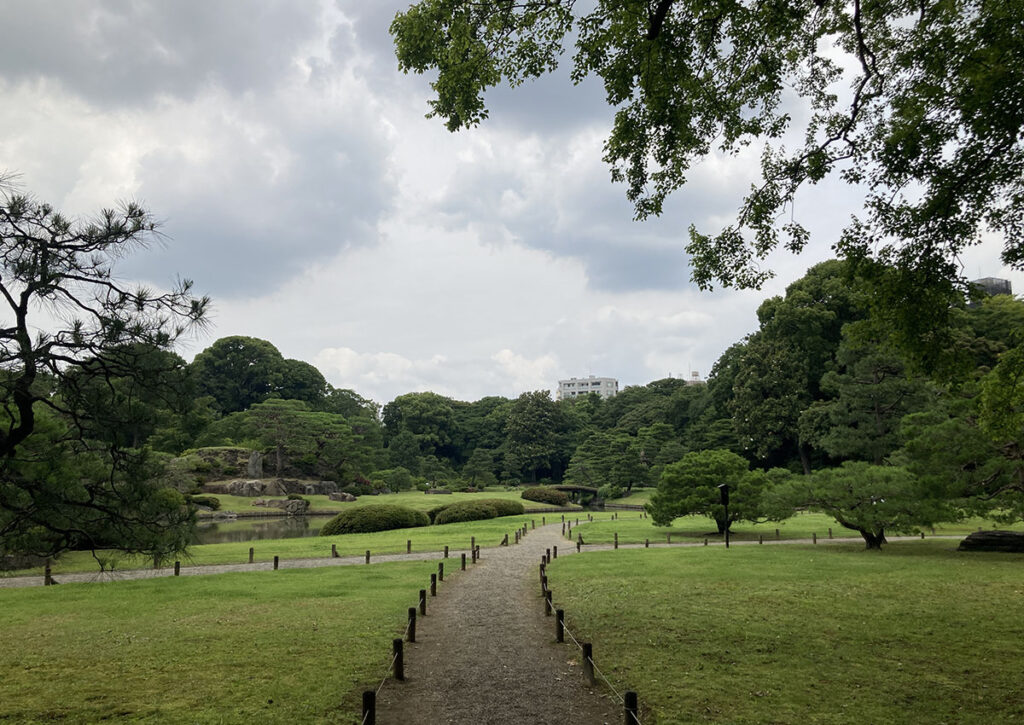Rikugien, with its impressive red brick outer wall, was built during the reign of Tsunayoshi Tokugawa, the fifth shogun, and was owned by Yataro Iwasaki, founder of the Mitsubishi zaibatsu, in the Meiji era. Rikugien” was designated as a Special Place of Scenic Beauty by the national government in 1953, and is one of the most representative feudal lord’s gardens of the Edo period.

History of Rikugien
In 1695, the fifth shogun of the Edo shogunate, Tokugawa Tsunayoshi, granted the Komagome site to Yanagisawa Yoshiyasu as his suburban residence. Yanagisawa Yoshiyasu, who as a grandee, was in charge of the shogunate administration, designed and directed the construction of a pond in a corner of Musashino and built a mountain, and over seven years the Rikugien was completed.
It is said that Lord Tsunayoshi was very fond of this park and visited it 58 times in his life.
It was selected as a national special place of scenic beauty in 1953, and is now called one of the two largest gardens in Edo along with the Koishikawa Korakuen Garden.


Rikugien as a tourist attraction
The name “Rikugi” is derived from the “Six senses of Poetry”, as ‘Fuu’, ‘Ga’, ‘Shou’, ‘Fu’, ‘Hi’, and ‘Kyou’, in the ancient Chinese poetry book “Mao Shi”, which were adapted by Ki No Tsurayuki to his classification system for classic Japanese poem.
Yoshiyasu has a deep knowledge of classic Japanese poem and literature, and has recreated 88 scenic spots that were written in Japanese historical works such as the Manyoshu and Kokinshu, in the park, so that visitors can still feel the footprints of Japanese culture and history handed down through the ages.
Rikugien was opened in 1938 and is a huge garden with an area of 88,000 square meters, with plants that change with the seasons. A large pond is dug in the center of the garden, and visitors can walk around it. At the height of its popularity, it attracts more than 30,000 visitors a day.



Attractions of Rikugien
The plants of the four seasons
The charm of Rikugien is that it is a park where you can enjoy the four seasons, with trees that change with the seasons.
In spring, a 70-year-old weeping cherry tree, 15 meters high and 20 meters wide, greets all visitors at the entrance of the garden.
In the fall, 600 trees, including maple and ginkgo, are illuminated in red and yellow to create a magical world.
Hydrangeas in summer, and camellias and Japanese plum trees in winter, and so on, give you a different view of the garden no matter what season you visit.




The garden pathway to enjoy the four seasons in Rikugien
Rikugien is a “strolling garden with artificial hill and pond ” where you can walk around the pond and enjoy the seasonal flora.
Along the way, you can enjoy different views of nature from various angles, such as the Togetsu Bridge and the Fujishiro Pass.
Togetsu Bridge was named after a poem that says, “Waka no ura, Ashibe no tazuru no nakigoe ni, Yo wataru tsuki no, Kage zo sabishiki”. Let’s cross this bridge, which is made of two large rocks, to the central island.
When the cherry and maple trees are in full bloom, the view from the top of the Fujishiro Pass is breathtaking.



If you are tired of strolling, take a break at the teahouse
If you get tired of walking, you can stop at a teahouse on the way.
The Fukiage Teahouse is located in the center of the park, where you can listen to the birds’ chirps and enjoy a cup of matcha while looking at the seasonal plants.
At Takimi Teahouse, you can take a break in the dimly lit teahouse during the daytime. Listening to the sound of a nearby mountain stream while enjoying a cup of matcha is a great way to relax and forget about the summer heat.
Away from the hustle and bustle of the Tokyo metropolis, Rikugien is a beautiful park where you can enjoy the richness of Japan’s four seasons not only visually, but also with all five senses. A walk through the park, which was designed by the literary guru Yoshiyasu Yanagisawa, will give you a taste of the history of the Manyoshu and Kokinshu and the beauty of Japan.





Access to Rikugien
6-16-3Hon-Komagome, Bunkyo City, Tokyo
TEL : +81-3-3941-2222
Parking around Rikugien
Rikugien Official Website
official site:https://www.tokyo-park.or.jp/park/format/about031.html
